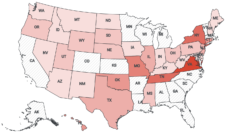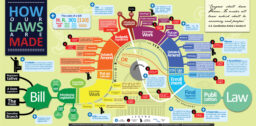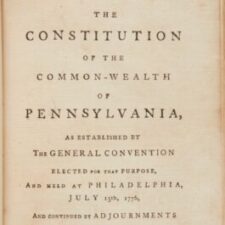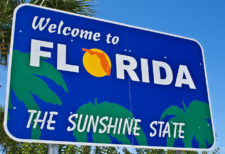 Most states require newspapers to have paying subscribers to publish notices but at least a few grant that authority to free-distribution papers as well. Those requirements don’t change very often which is why it’s so unusual to have two states considering legislation this year that would allow free papers to publish notices.
Most states require newspapers to have paying subscribers to publish notices but at least a few grant that authority to free-distribution papers as well. Those requirements don’t change very often which is why it’s so unusual to have two states considering legislation this year that would allow free papers to publish notices.
The newspapers supporting the measures in both states were founded by entrepreneurs in communities where the paid-circulation newspapers have experienced multiple rounds of layoffs and cutbacks in recent years. Taking the other side of the debate are the states’ press associations, both of which oppose the bills.
Newspaper notice targeted in multiple states
 Bills have been introduced in at least 15 states allowing or requiring official notice to be published on various platforms other than local newspapers. That’s significantly more legislative activity focused on replacing newspaper notice than last year and approaches the level of the previous election off-year of 2021.
Bills have been introduced in at least 15 states allowing or requiring official notice to be published on various platforms other than local newspapers. That’s significantly more legislative activity focused on replacing newspaper notice than last year and approaches the level of the previous election off-year of 2021.
What happens after the bill passes?
 For over 20 years, newspapers and their state press associations turned back every bill that authorized government units to issue public notice via their own websites instead of local newspapers. That winning streak ended last year when the Florida legislature gave state agencies and local governments the option to post notices on county websites.
For over 20 years, newspapers and their state press associations turned back every bill that authorized government units to issue public notice via their own websites instead of local newspapers. That winning streak ended last year when the Florida legislature gave state agencies and local governments the option to post notices on county websites.
The new law, which took effect on Jan. 1, has one upside. It set in motion a vast experiment that will tell us what local governments do when given this choice. Five weeks into the new year an answer is beginning to emerge: It depends primarily on the motivations of local elected officials and the actions local newspapers take in response to the challenge.
Colorado paper prevails in public notice case
 The Wet Mountain Tribune in December settled its slam-dunk federal lawsuit against the Custer County Board of Commissioner (BOCC) and will once again run the county’s public notices. The lawsuit claimed the BOCC violated the Tribune’s First Amendment rights by retaliating against it by awarding the county’s public notice contract to another local newspaper that is openly partisan.
The Wet Mountain Tribune in December settled its slam-dunk federal lawsuit against the Custer County Board of Commissioner (BOCC) and will once again run the county’s public notices. The lawsuit claimed the BOCC violated the Tribune’s First Amendment rights by retaliating against it by awarding the county’s public notice contract to another local newspaper that is openly partisan.
In addition to making the Tribune the county’s official newspaper again for the next four years, Custer County also agreed to pay the Tribune $50,000. That’s about three times as much as the county spends annually on its notices, according to Tribune owner Jordan Hedberg’s (photo above) estimate.
Expanding public notice eligibility requirements
 The newspaper industry that existed when public notice laws were originally enacted is a thing of the past. There are fewer newspapers and they have less circulation. The papers are physically smaller and sometimes they’re designed, edited and/or printed at great geographical distances from the local markets in which they circulate. They’re also published electronically with a reach and immediacy that were unprecedented in the pre-internet era.
The newspaper industry that existed when public notice laws were originally enacted is a thing of the past. There are fewer newspapers and they have less circulation. The papers are physically smaller and sometimes they’re designed, edited and/or printed at great geographical distances from the local markets in which they circulate. They’re also published electronically with a reach and immediacy that were unprecedented in the pre-internet era.
These changes have made it increasingly difficult for newspapers and government agencies to discharge their responsibilities under public notice laws enacted many decades ago. As a result, state press associations otherwise reluctant to meddle with public notice statutes now may find it necessary to advocate for changes to ensure the laws that determine which papers qualify to publish notices remain relevant.
Newspaper notice still going strong
 Here’s a USC Annenberg Center on Communication Leadership & Policy study from 2010, entitled “Insult to injury: The disappearance of public notices in US newspapers”.
Here’s a USC Annenberg Center on Communication Leadership & Policy study from 2010, entitled “Insult to injury: The disappearance of public notices in US newspapers”.
The final paragraph of the report includes the following claim: “This brief in no way advocates for the demise of public notices, yet in an era of cost cutting and online information distribution newspapers are increasingly facing a reality of online-only public notices.”
The newspaper industry’s challenge
 A recent column on the nonprofit news website the Pennsylvania Capital-Star argues that Pennsylvania voters should receive more notice about proposed amendments to the state’s Constitution advanced by Republican lawmakers this year. The column’s author, Patrick Beaty, believes the notice requirements set by the Constitution are insufficient.
A recent column on the nonprofit news website the Pennsylvania Capital-Star argues that Pennsylvania voters should receive more notice about proposed amendments to the state’s Constitution advanced by Republican lawmakers this year. The column’s author, Patrick Beaty, believes the notice requirements set by the Constitution are insufficient.
We have no position on the substance of the amendments or on Beaty’s call for more transparency surrounding the amendment process.
Nevertheless, his column offers an excellent illustration of a major challenge facing the newspaper industry: To reframe the debate around public notice by helping people understand that notices published in newspapers are also published on newspaper websites.
Scope of Florida’s new public notice law questioned
 As we previously reported, the new Florida public notice statute set to take affect on Jan. 1 is beset with ambiguity. In general, the statute is designed to give local governments the option to publish notices on their county website in lieu of newspapers. But as the dust has settled from the battle over House Bill 7049, fears about the immediate damage it will wreak on public notice in the state have diminished.
As we previously reported, the new Florida public notice statute set to take affect on Jan. 1 is beset with ambiguity. In general, the statute is designed to give local governments the option to publish notices on their county website in lieu of newspapers. But as the dust has settled from the battle over House Bill 7049, fears about the immediate damage it will wreak on public notice in the state have diminished.
A survey of statewide public notice websites
 Statewide public notice websites sponsored by the newspaper industry have been the focus of major change in the last few years. Many states enacted new laws requiring notices to be published on the sites and about two dozen state press groups have switched website vendors.
Statewide public notice websites sponsored by the newspaper industry have been the focus of major change in the last few years. Many states enacted new laws requiring notices to be published on the sites and about two dozen state press groups have switched website vendors.
The vendor shift has been driven by the growing adoption of online ad-entry systems and the withdrawal from the market of the first vendor to license a web-based platform to power the websites.
How not to defend public notice
 Custer County isn’t the only jurisdiction in Colorado where controversy has erupted over the publication of local notices. Greenwood Village and Pitkin County have had their own recent dust-ups over the designation of their local papers of record. The Pitkin County story is particularly instructive for the wrong reasons.
Custer County isn’t the only jurisdiction in Colorado where controversy has erupted over the publication of local notices. Greenwood Village and Pitkin County have had their own recent dust-ups over the designation of their local papers of record. The Pitkin County story is particularly instructive for the wrong reasons.
In late July, Pitkin’s Board of County Commissioners (BOCC) adopted the Aspen Daily News as its new official newspaper, displacing the Aspen Times, a daily that had served as the ski town’s paper of record since 1993. The Times had changed ownership at the beginning of the year, igniting several local controversies that apparently motivated the commissioners to make the change.
Colorado paper files slam-dunk lawsuit over lost notices
 The Wet Mountain Tribune filed a federal lawsuit last month accusing the local Board of County Commissioners (BOCC) of punishing it by awarding Custer County’s public notice contract to another newspaper. The lawsuit alleges the BOCC violated the Tribune’s First Amendment rights by retaliating against it for reporting factual matters the Board would have preferred to keep hidden.
The Wet Mountain Tribune filed a federal lawsuit last month accusing the local Board of County Commissioners (BOCC) of punishing it by awarding Custer County’s public notice contract to another newspaper. The lawsuit alleges the BOCC violated the Tribune’s First Amendment rights by retaliating against it for reporting factual matters the Board would have preferred to keep hidden.
The paper appears to have a very strong case.
